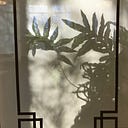Learning Tarot: The High Priestess & King of Swords

The High Priestess appears slightly solemn and guarded, as if she is keeping a secret. The columns at her sides and her headdress evoke Egypt or another ancient civilization, perhaps the origin of the secrets she guards, and a thin sliver of a moon rests at her feet, lightly held by a cascading fold of her garment. Her blue cloak encloses her, and she holds a scroll. The tight composition of the two columns in relation to her positioning between them, as well as the corresponding position of the letters on the columns and symbol on her chest, weave her tightly into the space, almost as if she is part of a pattern or tapestry. Just behind her, suspended from the columns is a patterned hanging cloth of pomegranates and a palm-like greenery, adding a hint of abundance and juiciness. She is doubly enclosed by her blue cloak and the positioning of the columns around her. Behind her, beyond the columns and pomegranates, is the suggestion of a lake.

The King of Swords is seated on a throne, the top of which we do not see, and which extends beyond the upper edge. It echoes the upright sword he holds in its elongated verticality. Upon the throne are depicted butterflies and the suggestion of a figure who may have wings. Behind the King, the horizon line is very low and the entire space is comprised of a pale, clear sky with clouds. The coloring of the sky echoes the grey-silver of the throne and sword. The element here is likely air or space. The impression overall is one that is restrained, with perhaps the clarity of the fine edge associated with blades, and a sense of the abstract and theoretical.
Taken together, the King of Swords seems to come forward, while the High Priestess holds her space. The King holds his sword not perfectly vertical, but at a slight angle, suggesting a potential for action.
The High Priestess is the mediator between our waking and dreaming selves, a teacher who offers wisdom. She may be identified with inner intuition. The “B” and “J” on the columns are a reference to two metal columns, named Boaz and Joachim, of the Temple of Solomon. She is the second card in the deck, and is also connected with Persephone, who travels into and out of the underworld.
The King of Swords represents authority and mental power. With his sharp cheekbones, he does seem to evoke a somewhat angular presence, sharp and agile.
One way to learn Tarot is to spend time familiarizing yourself with the visuals, and then looking up the cards and symbols as they are usually interpreted. I’m using the recolored version of the Universal Waite.
